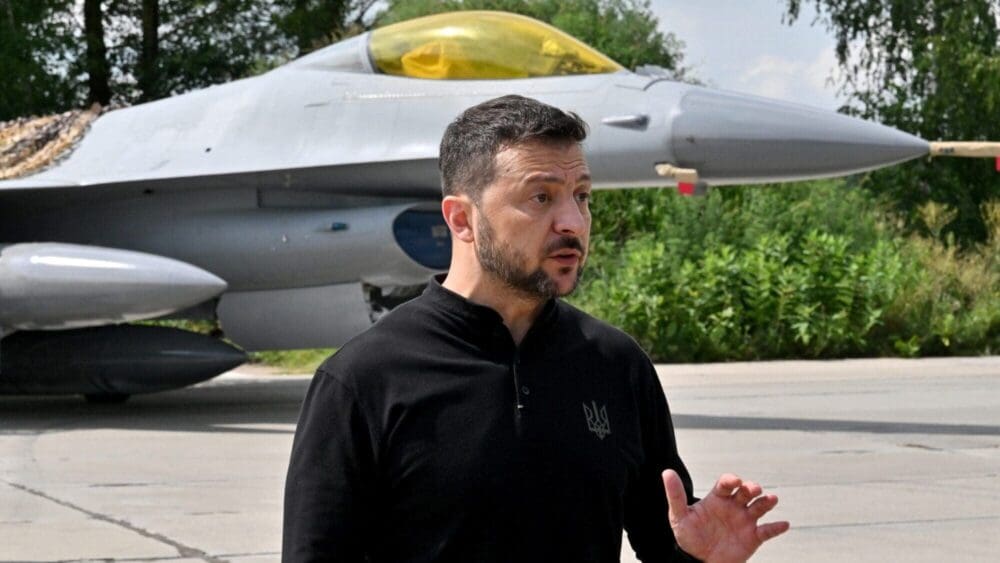
President Zelensky unveiling the first donated F-16s in early August
Sergei Supinsky / AFP
Following another major overnight Russian rocket barrage targeting the Ukrainian capital, President Zelensky took to social media to demand Western allies implement their “obligations” to send the proper air defense equipment. He pleaded for both the authorization of the use of long-range weaponry against Russian targets and for more direct Western involvement in the future.
“We need solutions,” said Zelensky—but if his appeals are successful, it could result in a significant regional expansion of the war zone.
“In the various regions of Ukraine, we could do much more to protect lives if the air forces of our European neighbors would work together with our F-16 fighter jets and our anti-aircraft defenses,” the president said in a live address on his Telegram page.
America, Britain, France, and other partners have the power to help us stop terrorism. We need solutions.
If this unity has worked so well in the Middle East, it should work in Europe,” Zelensky added, referring to ballistic missile defense support provided to Israel and international vessels in the Red Sea by a coalition of Western allies.
Unfortunately, the same strategy that was feasible against Houthi rebels and their missiles over the Red Sea might yield very different results in Ukraine. Launching air defense missiles from NATO territory—even without any Western aircraft crossing into Ukraine—would be certainly regarded by Russia as direct involvement in the war, possibly leading to a major escalation.
Another red line of the Kremlin is using long-range Western weaponry—self-guiding ballistic cruise missiles with hundreds of kilometers of effective range—to strike targets deep inside Russian territory. The U.S., the UK, France, and Germany have provided such weapons so far, but remain reluctant to allow using them across the Russian border.
“We expect decisions from them—decisions on our long-range capabilities,” Zelensky said in a subsequent video address a few hours after the first one, asking for authorization to strike back at Russia:
This is the optimal counter-terrorism tactic, one that every partner of ours has the right to and would undoubtedly use to protect themselves.
The Ukrainian Air Force currently has 10 F-16 fighter jets in its service, the first batch from among the nearly 80 jets pledged so far by Belgium, the Netherlands, Denmark, and Norway to be delivered between 2024 and 2025, although the number is only expected to rise to 20 by the end of this year.
These 10 aircraft are not nearly enough to make a difference in the course of the war yet—especially since the strategy is to keep them far from the frontlines and the Russian air defenses in order not to lose them—so they are hardly more than just a symbol of hope at this point. Equipped with the right weaponry, however, the F-16s could be a welcome addition to the air defense of larger cities at least, including Kyiv.
Monday, August 26th, marked the second consecutive day of large-scale Russian missile and drone attacks covering nearly the entire country. Zelensky described the attack as one of the biggest since the invasion, with over a hundred missiles and the same number of kamikaze drones targeting Ukraine—including critical civilian infrastructure—in a single night.
Against the backdrop of these events, it is particularly important that our partners implement their obligations regarding air and missile defense systems. Ukraine and the West should also finally achieve the joint shooting down of missiles and drones.
Among other parts of Ukraine’s energy infrastructure, one of the targets of the shelling appeared to be the Kyiv Hydroelectric Power Plant just north of the capital. Although the missile only took out the control rooms and left the dam mostly untouched, observers noted that its possible collapse due to subsequent attacks would “permanently” flood large parts of the city, destroying the homes of millions of people living downstream.
Russia tried to hit Kyiv Hydroelectric Power Plant today during missile attack located on the Dnieper River in Vyshhorod, Kyiv region, Central Ukraine.
— Clash Report (@clashreport) August 26, 2024
Damaging the Kyiv HPP could lead to severe flooding of cities and villages downstream along the Dnipro River.
If successful,… pic.twitter.com/cYqACBYRaD
